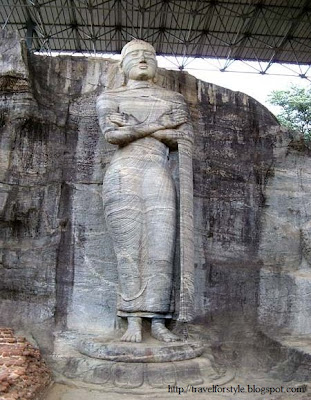It was constructed in the 12th century by Parakramabau 1. These four Buddha sculptures (two are seen here; closeups of them, and the other two, on the following. were carved out of a single granitic outcrop, and were originally protected by individual enclosures. Art historians justifiably consider them to the the best rock-carved statues in Sri Lanka, because of their serene yet humanistic expressions and the technical excellence of their stonework. They date to the 11th century, although the seated figure in the excavated cave may be 10th century. The beauty and historical importance of these sculptures has given rise to several different interpretations. Briefly, some scholars think that the standing figure represents Ananda, and others (inconsistently) that the reclining figure represents Buddha asleep rather than in Parinrvana.The modern consensus is that all four are Buddha, and that the sleeping figure is indeed in Parinirvana.
Standing Buddha
The
statue is 7m (23 ft) tall. Its arms-crossed posture is unusual, and has
elicited some technical discussions that - to summarize - have identified this
figure as either Ananda (but probably not, in my opinion), or else as the
Buddha in the second week after his enlightenment,The figure stands upon a
lotus throne. His subtle bend at the waist, that is consistent with his
turned-out left foot, is admirable.
Reclinging Buddha
The
entire statue is 14m (46 ft) long, perhaps not coincidentally the height of the
colossal standing Buddha atLalitalanka. His face, seen in close-up here, is
serene and peaceful, resting his acorn-shaped head (sic) upon a bolster.
The natural striations of the rock have been used to good effect in order to
indicate the subtle folds of the Buddha's gown. Probably this statue represents
the Buddha in gentle Parinirvana, although it has also been interpreted as
simply asleeping Buddha.
Meditating Buddha
This meditating Buddha with attendants
is still enclosed by his original rock-cave, as well as some modern wire cages.
It is the earliest statue at Gal Vihara (possibly 10th century, previous
pages), and the second from the left as you face the site.




No comments:
Post a Comment